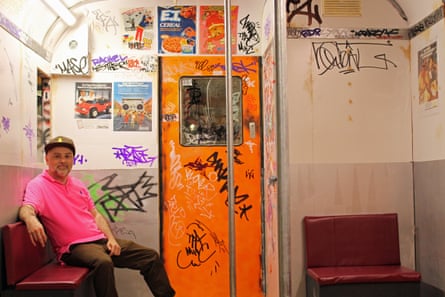“This is mind-blowing – it’s my dream come true,” says Monk, as we walk through Leeds City Museum, where boxes of hip-hop memorabilia are scattered everywhere.
A record shop is being constructed in one corner, a 1990s bedroom studio in the other. Behind me a full-size replica of a graffiti-covered 1980s New York subway train is being finished. The revered Leeds MC and artist LSK hands me a pen and instructs me to tag the train. Bereft of talent or ideas, I hastily scribble my initials in a childlike scrawl. He nods for me to do more, so on gothe names of my wife and my dog.
Co-curated with the Hip Hop Historian Society – founded by Monk, a Leeds MC, graffiti artist and educator – A Hip Hop Journey: 50 Years of Kulture is an exhibition focusing on five pillars of hip-hop: DJing, MCing, aerosol art, B-boy and B-girl style, and knowledge. But unlike most retrospectives, it also focuses on Leeds’ own hip-hop history. “Leeds has been so slept on,” says Testament, a Leeds-based MC, writer and world record-breaking human beatboxer. “It’s still slept on.”
As with many musical revolutions in the UK, its roots can be traced to sound system culture, from the Count Johnny system in the 1960s to Chapeltown’s Jungle Warrior system and the Iration Steppas. “It was a big thing for us as kids,” says George Evelyn, AKA Nightmares on Wax, whose new track Come On Then nods back to this early hip-hop era. “But we weren’t old enough to go, so you’d just get snippets.”
Something more accessible soon landed: Evelyn remembers being a 12-year-old in 1982 when Malcolm McLaren’s Buffalo Gals aired on Top of the Pops. “At school the next day, everybody was breakdancing and body popping,” he says. “It was insane – a massive paradigm shift.”
Paul Edmeade, AKA Oddball, who later became a member of the influential Leeds hip-hop group Breaking the Illusion (BTI), also remembers the track hitting hard. “Calendar did a feature about it,” he laughs, recalling the regional TV piece. “Someone was scratching on a turntable so straight away I went to my mum’s record player.” Edmeade’s house was broken into and a VCR player stolen and the insurance money afforded him a single Technics turntable to practise his new obsession.
“Hip-hop came along and it was like, I’ve got a voice,” he says. “It brought something different out in everybody: graffiti artists, MCs, dancers, turntablists. All of a sudden we were like local superheroes because we were given these abilities.”
Evelyn joined the Bradford breakdancing crew Solar City Rockers and it was serious business. They had a manager, sponsorship from a local hairdresser, and custom-made tracksuits. Competitions were fierce and intense. “You could feel the pressure in the room,” Evelyn says. Events were such a draw that he recalls one promoter running off with all the door takings.
While kids in homemade tracksuits furiously windmilled on hired badminton courts to the “out-of-this-world and alien” sounds of Afrika Bambaataa, a veteran of the sound system scene, MC Daddy Speedo, became Leeds’ first MC of note in this new era. Rapping locally as early as 1983, he later joined a pre-Faithless Maxi Jazz in his hip-hop outfit the Soul Food Café.
Hip-hop, electro and the burgeoning dance scene were initially all connected. DJ Martin Williams, an early collaborator with bleep techno pioneers LFO, sought out Edmeade’s scratching skills in return for teaching him how to mix, while Evelyn was increasingly blurring lines between electro, hip-hop and proto-rave.

By 1989, BTI had signed with Manchester label Play Hard, run by Hacienda DJ Dave Haslam and Nathan McGough. “Nathan was giving me the usual manager spiel,” says Edmeade. “Saying, I’ve got this other band, but don’t worry, I’m gonna dedicate all my time to you.” The other band? Happy Mondays. “We had no idea who they were,” says Edmeade, laughing. “We were innocent wide-eyed, hip-hop kids. Obviously, they blew up and then these guys had no interest in us. So, Tom [Stewart, of BTI] was like: ‘Let’s do it ourselves.’”
Low Life Records began in 1992 and would become the biggest UK hip-hop label, featuring another talented Leeds rapper, Braintax; MCs such as the late Tozz 180, heard on Nightmares on Wax’s debut album, resulted in Leeds becoming a flourishing centre.
Many artists brought up on the template of US hip-hop were now beginning to wrestle with their own British, even regional, identities. Edmeade left BTI in 1993 and joined the major label-signed outfit Kaleef. “I remember rapping and they started laughing,” he says. “They were like: ‘What are you rapping all Yorkshire for?’ They were doing all this pseudo American stuff.” But the outfit leaned into their British roots more, sampling the Stranglers and the Pretenders, resulting in a string of tracks nearing the top 20.
“When I moved to Leeds in 1997, I was still rapping in an American accent,” says Testament. “I was in the final of a rap battle with Tommy from BTI and he won but Monk and Oddball took me aside and were like: ‘Bro, you could have won that if you didn’t have an American accent.’ I’m now an adopted Yorkshireman and very proud to represent.”
By 1999, Huddersfield rapper Jehst – who made music inspired by the harsher elements of Yorkshire life “fuelled by the bleak reality of the smack-infested post-industrial north” – had set up another local label, YNR Productions, with Leeds’ Tommy Evans. In 2001, the thriving local scene formed a hip-hop collective-cum-cooperative, the Invizible Circle, with 30 members each chucking in £20 a month for a communal fund. “We set up a recording studio and a label,” says Monk. “We became a close-knit community that was different to anywhere else in the country.”
By 2003, First Word Records – later voted label of the year by Gilles Peterson’s Worldwide FM – had also set up in Leeds, and Low Life, even though now moved to London and under sole control of Braintax, had become a vital label, releasing work by Task Force, Jehst, and in 2004 the game-changing Council Estate of Mind by Skinnyman, another rapper who was born in Leeds. The album was quintessentially, unashamedly British – initially written as poems while he was in prison, reflecting on contemporary working-class life in Britain.
In 2005, BTI returned, just as Stewart, after a prolonged break with a proudly West Yorkshire anthem. “L.E.E.D.S!” Stewart shouts out on Never in a Million, kicking off a brilliantly self-deprecating track about all the things he will never achieve in life – a dour yet acerbic antithesis to the swagger of mainstream club rap of the time.
But just when Leeds and UK hip-hop’s voice felt at its most potent and mobilised, momentum haltered. Skinnyman wasn’t able to capitalise on the success of his record due to repeat prison stints, while the London-centric grime had shifted from underground movement to chart music. “Grime was a gift and a curse,” reflects Jehst. “It empowered us as much as it took our power away. It changed the perception of what UK rap music is, but it also created a lot of weird stigmas. The narrative was: hip-hop is never gonna work in the UK but grime is the future – but breakout hits like Fix Up, Look Sharp was a Billy Squier beat that had been a hip-hop break for 20-plus years, famously rapped over by Run DMC. It was a false equivalence to separate that shit.”
The focus around this time was heavily on London. “Anything outside the M25 was like sheep land to a lot of people,” says Monk. A further fracture in the UK hip-hop community occurred when Low Life ended suddenly in 2008 with Braintax “literally disappearing”, according to Jehst. Many artists on the label allege significant money owed, with Skinnyman claiming he has never earned a penny from his landmark album. “For some people it had a huge impact on fucking their lives up,” says Jehst.

Many of Leeds’ brightest talents, such as producer and prolific beat-maker Kidkanevil – who has gone on to work with MIA, Massive Attack, and Ocean Wisdom – left the city, as did First Word. “The talent is there but that’s what happens when the business infrastructure isn’t,” says Jehst, who also left for London years earlier. It has emerged that MF Doom, the linchpin of US underground rap, was living in the city when he died, but was way off the city’s hip-hop grid: “We found out [he was here] just after he passed,” Monk says. “It was quite a secret.”
But a new crop of Leeds artists has sprung up and found success, continuing the city’s rich lineage. The more R&B-leaning Cole LC is signed to a major, while the likes of Graft and Dialect are proudly Leeds in their work. The latter’s supreme battle rap skills have seen him take on big hitters such as AJ Tracey – he was voted man of the match in said battle – as well as an especially memorable one with the rapper Daylyt. In it, the American strips off until he is completely naked except for what looks like hospital-issued underwear. Panic, bewilderment and unease fills the crowd until a deep Leeds accent cuts through it, yelling out: “Ya sexy bastard!”
Many of those from the original Leeds scene who are still in the city are all deeply invested in community work through education, workshops, and working with at-risk youth. It has been vital for Monk, and underpins much of the intention behind the exhibition. “Hip-hop has been such a positive force for me,” he says, surrounded by history. “I grew up on a council estate and it genuinely saved my life. Giving that positivity back and trying to uplift the community has been my lifelong journey.”

